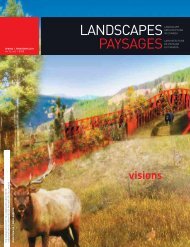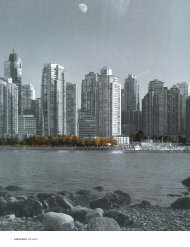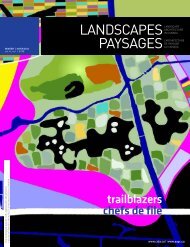time + place temps + lieu - CSLA :: AAPC
time + place temps + lieu - CSLA :: AAPC
time + place temps + lieu - CSLA :: AAPC
Create successful ePaper yourself
Turn your PDF publications into a flip-book with our unique Google optimized e-Paper software.
ESSAY<br />
When<br />
JULIAN SMITH<br />
THE CURTAINS came<br />
down at RIDEAU HALL…<br />
FR_www.csla.ca<br />
LES RIDEAUX DE RIDEAU HALL<br />
At this year’s <strong>CSLA</strong> Congress in Halifax,<br />
Julian Smith became an honourary member<br />
of the <strong>CSLA</strong>. Mr. Smith is a highly regarded<br />
architect who is internationally recognized<br />
for his contributions to the field of heritage<br />
conservation, in particular, to cultural landscape<br />
theory and practice.<br />
His work and his ideas are referenced<br />
repeatedly in this issue, in large part because he<br />
has emphasized the importance of landscape<br />
and landscape architecture throughout<br />
his career. His use of a cultural landscape<br />
framework allows him to move across the<br />
boundaries between architecture, landscape<br />
and urban design. Julian Smith’s thinking is<br />
perhaps nowhere better illustrated than in<br />
this piece first published in Phillips Farevaag<br />
Smallenburg’s excellent book, “Grounded.”<br />
The essay describes work done with PFS at the<br />
Governor General’s residence, Rideau Hall.<br />
Rideau Hall began as a private residence,<br />
and, in the mid-nineteenth century, was<br />
designated the official residence of the<br />
Governor General of Canada. The project<br />
involved the preparation of a landscape<br />
master plan for the 29-hectare (72-acre) site.<br />
As with Confederation Square, there was a discernible tension between<br />
heritage advocates and contemporary design advocates from the start. This<br />
site was fresh from controversy over a recent memorial rose garden, and<br />
there was an inevitable sense of “either/or.” Julian Smith & Associates and<br />
PFS needed a cultural landscape approach to overcome these suspicions. The<br />
key factor at this site was the difference between initial observation and<br />
subsequent experience. It is in how a <strong>place</strong> is experienced that continuity and<br />
change can intersect in fruitful ways.<br />
The focus on observation had led the National Capital Commission to<br />
propose a large new visitor centre at the entrance to the site, with large<br />
windowed public areas providing dramatic views of the Rideau Hall grounds<br />
and entrance drive winding up to the house in the distance. The house was<br />
seen as an object in the landscape, and the visitor centre was meant to frame<br />
this view. The problem was that the visitor centre would solidify the idea of<br />
the residence as an object to be observed, rather than allowing it to be an<br />
experiential environment. As the historians pointed out in our discussions<br />
with them, the primary intent of the original landscape design was to draw<br />
one in to the centre of the site and then organize the landscape from that<br />
point outwards. It would not be possible to understand the subtleties of<br />
the design from the outside. One had to enter the site and experience it<br />
from the inside.<br />
The pivotal moment in the design process occurred when Greg Smallenberg<br />
asked if we could enter all of the rooms inside the house to view the landscape<br />
from the interior. It was explained, with some embarrassment that, in fact,<br />
all of the windows had had sheer curtains fixed in <strong>place</strong> for years, and that<br />
one was not really able to see the landscape from inside. It was then that we<br />
realized that the reason the landscape was in danger was that no one was<br />
experiencing the landscape the way it was intended to be experienced. Tens of<br />
thousands of visitors every year were reinforcing what the governors’ general<br />
themselves had been feeling: that the residence was an object set entirely<br />
1<br />
2 3 4<br />
22 LANDSCAPES PAYSAGES






